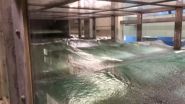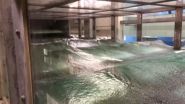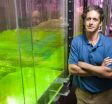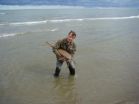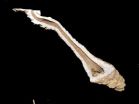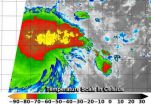(Press-News.org) VIDEO:
This is the one-of-a-kind, Alfred C. Glassell, Jr., SUSTAIN research facility at the UM Rosenstiel School of Marine and Atmospheric Science, where Haus and colleagues will conduct further studies on...
Click here for more information.
MIAMI – New research from University of Miami (UM) Rosenstiel School of Marine and Atmospheric Science suggests that physical conditions at the air-sea interface, where the ocean and atmosphere meet, is a key component to improve forecast models. The study offers a new method to aid in storm intensity prediction of hurricanes.
"The general assumption has been that the large density difference between the ocean and atmosphere makes that interface too stable to effect storm intensity," said Brian Haus, UM Rosenstiel School professor of ocean sciences and co-author of the study. "In this study we show that a type of instability may help explain rapid intensification of some tropical storms."
Experiments conducted at the UM Rosenstiel School Air-Sea Interaction Salt Water Tank (ASIST) simulated the wind speed and ocean surface conditions of a tropical storm. The researchers used a technique called "shadow imaging," where a guided laser is sent through the two fluids – air and water – to measure the physical properties of the ocean's surface during extreme winds, equivalent to a category-3 hurricane.
Using the data obtained from the laboratory experiments conducted with the support of the Gulf of Mexico Research Initiative (GOMRI) through the CARTHE Consortium, the researchers then developed numerical simulations to show that changes in the physical stress at the ocean surface at hurricane force wind speeds may explain the rapid intensification of some tropical storms. The research team's experimental simulations show that the type of instability, known as Kelvin-Helmoltz instability, could explain this intensification.
Haus and colleagues will conduct further studies on hurricane intensity prediction in the new, one-of-a-kind Alfred C. Glassell, Jr., SUSTAIN research facility located at the UM Rosenstiel School. The SUrge-STructure-Atmosphere INteraction laboratory is the only facility capable of creating category-5 level hurricanes in a controlled, seawater laboratory. The nearly 65-foot long tank allows scientists to simulate major hurricanes using a 3-D wave field to expand research on the physics of hurricanes and the associated impacts of severe wind-driven and wave-induced storm surges on coastal structures.
The SUSTAIN research facility is the centerpiece of the new $45 million Marine Technology and Life Sciences Seawater Complex at the UM Rosenstiel School where scientists from around the world have access to state-of-the-art seawater laboratories to conduct an array of marine-related research.
The study, titled "The air-sea interface and surface stress under tropical cyclones" was published in the June 16 issue of the journal Nature Scientific Reports. The paper's lead author was Alex Soloviev of the UM Rosenstiel School and Nova Southeastern University Oceanographic Center and its co-authors include: Mark A. Donelan from the UM Rosenstiel School; Roger Lukas of the University of Hawaii; and Isaac Ginis from the University of Rhode Island.
INFORMATION:
About the University of Miami's Rosenstiel School
The University of Miami is one of the largest private research institutions in the southeastern United States. The University's mission is to provide quality education, attract and retain outstanding students, support the faculty and their research, and build an endowment for University initiatives. Founded in the 1940's, the Rosenstiel School of Marine & Atmospheric Science has grown into one of the world's premier marine and atmospheric research institutions. Offering dynamic interdisciplinary academics, the Rosenstiel School is dedicated to helping communities to better understand the planet, participating in the establishment of environmental policies, and aiding in the improvement of society and quality of life. For more information, visit: http://www.rsmas.miami.edu.
Study provides new approach to forecast hurricane intensity
UM Rosenstiel School scientists offer new information to help improve tropical storm forecasting
2014-07-10
ELSE PRESS RELEASES FROM THIS DATE:
Extinct sea scorpion gets a Yale eye exam, with surprising results
2014-07-10
Poor peepers are a problem, even if you are a big, bad sea scorpion.
One minute, you're an imperious predator, scouring the shallow waters for any prey in sight. The next, thanks to a post-extinction eye exam by Yale University scientists, you're reduced to trolling for weaker, soft-bodied animals you stumble upon at night.
Such is the lot of the giant pterygotid eurypterid, the largest arthropod that ever lived. A new paper by Yale paleontologists, published in the journal Biology Letters, dramatically re-interprets the creature's habits, capabilities, and ecological ...
Despite setback, 'Mississippi Baby' represents significant breakthrough in effort to end AIDS
2014-07-10
Washington, D.C.—July 10, 2014—In response to today's announcement that the "Mississippi Baby," believed to have been functionally cured of HIV, has now been found to have detectable levels of the virus, the Elizabeth Glaser Pediatric AIDS Foundation (EGPAF) expresses disappointment in this setback but remains hopeful that the scientific breakthrough that allowed the child's HIV levels to remain undetectable for more than two years will continue to help researchers understand how to control HIV and ultimately develop a cure.
"Although we had high hopes that the child ...
Hubble spots spiral bridge of young stars linking two ancient galaxies
2014-07-10
NASA's Hubble Space Telescope has photographed an unusual structure 100,000 light years long, which resembles a corkscrew-shaped string of pearls and winds around the cores of two colliding galaxies.
The unique structure of the star spiral may yield new insights into the formation of stellar superclusters that result from merging galaxies and gas dynamics in this rarely seen process.
"We were surprised to find this stunning morphology. We've long known that the 'beads on a string' phenomenon is seen in the arms of spiral galaxies and in tidal bridges between interacting ...
Active shooter training increases comfort level of emergency responders
2014-07-10
(Boston) – Emergency Medical Service (EMS) responders felt better prepared to respond to an active shooter incident after receiving focused tactical training according to a new study in the journal Prehospital and Disaster Medicine. This is the first study to specifically examine the EMS provider comfort level with respect to entering a scene where a shooter has not yet been neutralized or working with law enforcement personnel during that response.
Incidents such as the Columbine High School shooting, the Virginia Tech campus shooting, the 2009 Fort Hood shooting, the ...
Scorpions are master architects, according to new research from Ben-Gurion University
2014-07-10
BEER-SHEVA, Israel – Ben-Gurion University of the Negev scientists have discovered that scorpions create a platform in their burrows where they warm up before the evening hunt.
As ectothermic animals, scorpions rely on energy from the environment to regulate
their internal temperature. The researchers believe that this platform provides a safe, warm spot for the scorpions to increase their body temperature before they leave their hiding places to forage at night.
After trapping the wild large-clawed scorpions (Scorpio maurus palmatus) in Israel's Negev desert the ...
NASA-NOAA Suomi NPP satellite sees power within newborn Tropical Depression 09W
2014-07-10
As the Northwestern Pacific is bidding goodbye to Tropical Cyclone Neoguri, another tropical depression has formed. NASA-NOAA's Suomi NPP satellite passed over Tropical Depression 09W (TD09W) and captured infrared data on the storm indicating some powerful thunderstorms within.
Because TD09W is close to land areas, watches are already in effect. On July 10, a tropical storm watch is in force for Guam, Rota, Tinian and Saipan.
Tropical depression 09W was formerly known as low pressure System 92W. VIIRS instrument aboard NASA-NOAA's Suomi NPP satellite taken July 10 at ...
Scripps Florida scientists shed new light on nerve cell growth
2014-07-10
JUPITER, FL, July 10, 2014 – Amidst the astounding complexity of the billions of nerve cells and trillions of synaptic connections in the brain, how do nerve cells decide how far to grow or how many connections to build? How do they coordinate these events within the developing brain?
In a new study, scientists from the Florida campus of The Scripps Research Institute (TSRI) have shed new light on these complex processes, showing that a particular protein plays a far more sophisticated role in neuron development than previously thought.
The study, published in the journal ...
On the link between periodontitis and atherosclerosis
2014-07-10
Chronic oral infection with the periodontal disease pathogen, Porphyromonas gingivalis, not only causes local inflammation of the gums leading to tooth loss but also is associated with an increased risk of atherosclerosis. A study published on July 10th in PLOS Pathogens now reveals how the pathogen evades the immune system to induce inflammation beyond the oral cavity.
Like other gram-negative bacteria, P. gingivalis has an outer layer that consists of sugars and lipids. The mammalian immune system has evolved to recognize parts of this bacterial coating, which then ...
New research finds ocean's most abundant organisms have clear daily cycles
2014-07-10
Imagine the open ocean as a microbial megacity, teeming with life too small to be seen. In every drop of water, hundreds of types of bacteria can be found. Now scientists have discovered that communities of these ocean microbes have their own daily cycles—not unlike the residents of a bustling city who tend to wake up, commute, work, and eat at the same times.
What's more, it's not all about the sun. Light-loving photoautotrophs—bacteria that need solar energy to help them photosynthesize food from inorganic substances—have been known to sun themselves on a regular schedule. ...
Window of opportunity against HIV comes from 'fitness bottleneck'
2014-07-10
New research on HIV transmission shows that viral fitness is an important basis of a "genetic bottleneck" imposed every time a new person is infected. The findings define a window of opportunity for drugs or vaccines to prevent or limit infection.
HIV represents evolution on overdrive. Every infected individual contains a swarm of viruses that exhibit variability in their RNA sequence, and new mutations are constantly appearing. Yet nearly every time someone new is infected, this diverse population of viruses gets squeezed down to just one individual.
The genetic bottleneck ...
LAST 30 PRESS RELEASES:
Sea reptile’s tooth shows that mosasaurs could live in freshwater
Pure bred: New stem cell medium only has canine components
Largest study of its kind highlights benefits – and risks – of plant-based diets in children
Synergistic effects of single-crystal HfB2 nanorods: Simultaneous enhancement of mechanical properties and ablation resistance
Mysterious X-ray variability of the strongly magnetized neutron star NGC 7793 P13
The key to increasing patients’ advance care medical planning may be automatic patient outreach
Palaeontology: Ancient tooth suggests ocean predator could hunt in rivers
Polar bears may be adapting to survive warmer climates, says study
Canadian wildfire smoke worsened pediatric asthma in US Northeast: UVM study
New UBCO research challenges traditional teen suicide prevention models
Diversity language in US medical research agency grants declined 25% since 2024
Concern over growing use of AI chatbots to stave off loneliness
Biomedical authors often call a reference “recent” — even when it is decades old, analysis shows
The Lancet: New single dose oral treatment for gonorrhoea effectively combats drug-resistant infections, trial finds
Proton therapy shows survival benefit in Phase III trial for patients with head and neck cancers
Blood test reveals prognosis after cardiac arrest
UBCO study finds microdosing can temporarily improve mood, creativity
An ECOG-ACRIN imaging study solves a long-standing gap in metastatic breast cancer research and care: accurately measuring treatment response in patients with bone metastases
Cleveland Clinic presents final results of phase 1 clinical trial of preventive breast cancer vaccine study
Nationally renowned anesthesiology physician-scientist and clinical operations leader David Mintz, MD, PhD, named Chair of the Department of Anesthesiology at the UM School of Medicine
Clean water access improves child health in Mozambique, study shows
Study implicates enzyme in neurodegenerative conditions
Tufts professor named Fellow of the National Academy of Inventors
Tiny new device could enable giant future quantum computers
Tracing a path through photosynthesis to food security
First patient in Arizona treated with new immune-cell therapy at HonorHealth Research Institute
Studies investigate how AI can aid clinicians in analyzing medical images
Researchers pitch strategies to identify potential fraudulent participants in online qualitative research
Sweeping study shows similar genetic factors underlie multiple psychiatric disorders
How extreme weather events affect agricultural trade between US states
[Press-News.org] Study provides new approach to forecast hurricane intensityUM Rosenstiel School scientists offer new information to help improve tropical storm forecasting
